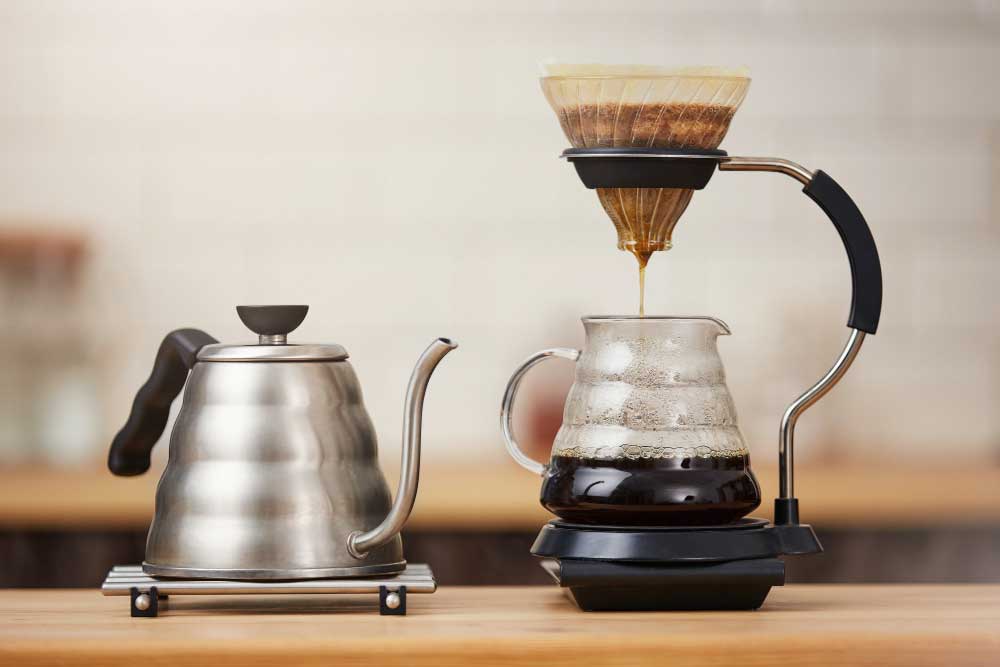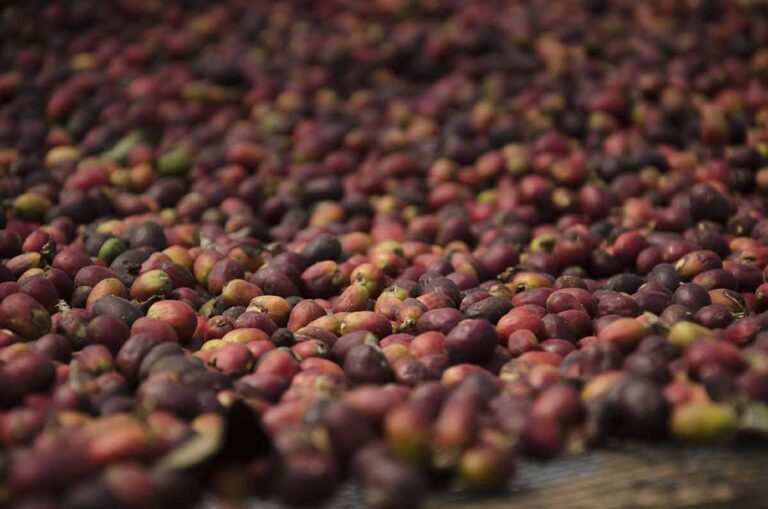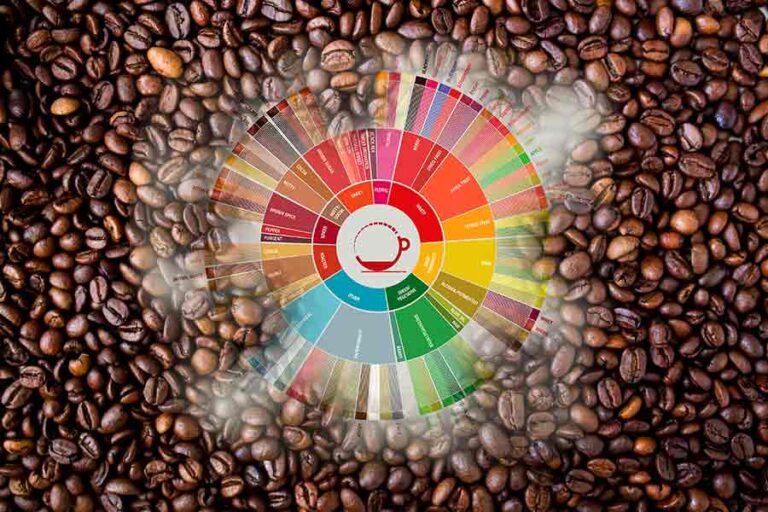Are you tired of the same old cup of coffee? Ready to unlock new flavors and indulge in a truly delectable brew? Look no further! In this article, we delve into the world of manual coffee brewing methods, taking you on a journey from beans to brew.
Whether you’re a coffee aficionado or just starting to explore the complexities of the perfect cup, we’ve got you covered.
Benefits of manual coffee brewing
Manual coffee brewing has gained popularity over the years, and for good reason. Unlike automatic coffee makers, manual brewing methods allow you to have full control over the brewing process, resulting in a cup of coffee that is tailored to your taste preferences.
The hands-on approach also allows you to appreciate the art and science behind coffee brewing.
One of the key benefits of manual brewing is the ability to unlock the full range of flavors and aromas present in your coffee beans. By adjusting the brewing variables, such as water temperature, grind size, and brew time, you can highlight specific characteristics of the beans and create a truly unique cup of coffee.
Manual brewing methods also tend to produce a cleaner and more nuanced cup, as they often involve a filtration process that removes any sediment or oils.
Another advantage of manual brewing is the flexibility it offers. With various brewing devices available, you can choose a method that suits your lifestyle and preferences. Whether you prefer a slow and meditative pour-over or a quick and convenient Aeropress, there is a manual brewing method for everyone.

Understanding different coffee-brewing devices
Before we dive into the step-by-step process of each brewing method, let’s take a moment to understand the different coffee brewing devices available.
Pour-over: This method involves pouring hot water over coffee grounds in a filter cone. The water drips through the grounds and into a vessel below, producing a clean and flavorful cup of coffee.
French press: The French press, also known as a press pot, is a classic brewing method that involves steeping coarsely ground coffee in hot water and then pressing a plunger to separate the grounds from the liquid.
Aeropress: The Aeropress is a versatile and compact brewing device that uses air pressure to extract flavors from the coffee grounds. It allows for a quick and convenient brewing process, making it a popular choice for coffee enthusiasts on the go.
Chemex: The Chemex is a visually stunning brewing device that uses a thick paper filter and a glass carafe. It produces a clean and smooth cup of coffee, highlighting the delicate flavors of the beans.
Siphon method: The siphon method, also known as a vacuum brewer, uses two chambers and a heat source to create a vacuum effect, pulling water through the coffee grounds and then filtering it back into the lower chamber. This method is known for its ability to extract the subtle nuances of coffee.
Each brewing device offers a unique approach to brewing coffee, and understanding their differences will help you choose the method that suits your taste preferences and brewing style.
The pour-over method: Techniques and tips for a perfect cup
The pour-over method is a favorite among coffee enthusiasts for its simplicity and ability to bring out the flavors and aromas of the coffee beans. Here’s a step-by-step guide to mastering the pour-over technique:
- Start by heating your water to the desired temperature. The ideal temperature for brewing coffee is between 195°F and 205°F (90°C and 96°C).
- Place a filter in the pour-over cone and rinse it with hot water. This helps remove any paper taste and preheats the cone and vessel.
- Measure and grind your coffee beans to a medium-fine consistency. The grind size will depend on the brewing time and the type of coffee you are using.
- Add the ground coffee to the filter, making sure it is evenly distributed. Place the pour-over cone on top of your coffee mug or carafe.
- Start pouring hot water over the coffee grounds in a slow, circular motion, starting from the center and working your way outward. This helps ensure an even extraction.
- Allow the coffee to bloom for about 30 seconds. This is when the coffee grounds release carbon dioxide, creating a bubbly reaction.
- Continue pouring water over the grounds, maintaining a steady and controlled flow. Aim to finish pouring within 2–3 minutes.
- Once all the water has passed through the grounds, remove the pour-over cone and discard the filter.
- Give the coffee a gentle stir to ensure an even distribution of flavors.
- Let the coffee cool for a moment before enjoying it. This allows the flavors to fully develop.
By following these steps and experimenting with different brewing variables, such as water temperature, grind size, and pour rate, you can achieve a pour-over coffee that is perfectly suited to your taste.
The French press: A classic brewing method with a full-bodied taste
The French press is a classic brewing method known for its full-bodied taste and rich flavor profile. Here’s how to brew a perfect cup using a French press:
- Start by heating your water to around 200°F (93°C), just below boiling point.
- Measure and coarsely grind your coffee beans. For the French press, a coarse grind will prevent the coffee from becoming overly bitter.
- Add the ground coffee to the French press. The general ratio is 1:15, meaning for every 1 gram of coffee, use 15 grams of water. Adjust this ratio to your preference.
- Pour a small amount of hot water over the coffee grounds, just enough to wet them. This is called the bloom, and it allows the coffee to release its flavors.
- After 30 seconds, pour the remaining hot water into the French press, making sure all the grounds are submerged.
- Place the plunger on top of the French press, but do not press it down. Let the coffee steep for 4 minutes.
- After 4 minutes, gently press the plunger down, separating the coffee grounds from the liquid.
- Pour the brewed coffee into your cup and enjoy.
The French press offers a full-bodied and robust cup of coffee. By adjusting the grind size and steeping time, you can further customize the flavor profile to your liking.
The Aeropress: A versatile and convenient brewing method
The Aeropress is a versatile and convenient brewing method that has gained a loyal following among coffee enthusiasts. Here’s how to brew coffee using an Aeropress:
- Start by heating your water to around 175°F (80°C). The lower temperature is recommended for the Aeropress to prevent over-extraction.
- Assemble the Aeropress by placing a paper filter in the filter cap and attaching it to the chamber.
- Measure and grind your coffee beans to a medium-fine consistency. The exact grind size will depend on personal preference and the specific Aeropress recipe you are using.
- Place the Aeropress on top of a sturdy mug or carafe, with the filter cap facing down.
Add the ground coffee to the Aeropress, ensuring it is evenly distributed. - Start a timer and pour a small amount of hot water over the coffee grounds, just enough to wet them. Stir gently to ensure all the grounds are saturated.
- After 30 seconds, slowly pour the remaining hot water into the Aeropress, using a circular motion.
- Once all the water is added, stir the coffee grounds again to ensure even extraction.
Attach the plunger to the Aeropress and apply gentle pressure, pressing the coffee through the filter and into your cup. The entire process should take around 60–90 seconds. - Remove the Aeropress from your cup and discard the coffee grounds and filter.
The Aeropress offers a versatile brewing experience, allowing you to experiment with different grind sizes, brewing times, and water temperatures. With its compact size and ease of use, it is a popular choice for coffee lovers who are always on the go.
The Chemex: A visually stunning brewing method for a clean and smooth cup
The Chemex is not only a brewing device but also a piece of art. With its elegant hourglass shape and thick paper filters, the Chemex produces a visually stunning cup of coffee that is clean and smooth. Here’s how to brew coffee using a Chemex:
- Start by heating your water to around 200°F (93°C).
Place a paper filter in the Chemex, ensuring that the triple-fold portion is facing the spout. - Rinse the filter with hot water to remove any paper taste, and preheat the Chemex.
Measure and grind your coffee beans to a medium-coarse consistency.
Add the ground coffee to the filter in the Chemex, making sure it is evenly distributed. - Start a timer and pour a small amount of hot water over the coffee grounds, just enough to wet them. This allows the coffee to bloom and release its flavors.
- After 30 seconds, slowly pour the remaining hot water over the grounds in a circular motion, starting from the center and working your way outward.
- Aim to finish pouring within 3–4 minutes, ensuring a steady and controlled flow rate.
Once all the water has passed through the filter, remove the Chemex from the scale and discard the filter and coffee grounds. - Serve the brewed coffee in your favorite cup or carafe.
Chemex is known for producing a clean and smooth cup of coffee, highlighting the delicate flavors of the beans. Its elegant design and visually appealing brewing process make it a favorite among coffee enthusiasts.
The siphon method: Unlocking the delicate flavors with a vacuum brewer
The siphon method, also known as a vacuum brewer, uses two chambers and a heat source to create a vacuum effect, resulting in a clean and flavorful cup of coffee. Here’s how to brew coffee using a siphon brewer:
- Start by heating your water to around 200°F (93°C).
- Assemble the siphon brewer by attaching the upper chamber (where the coffee will brew) to the lower chamber (where the water will be heated).
- Place a cloth or paper filter in the upper chamber, ensuring a secure fit.
- Measure and grind your coffee beans to a medium-fine consistency.
- Add the ground coffee to the upper chamber, ensuring it is evenly distributed.
- Fill the lower chamber with hot water, making sure not to exceed the maximum fill line.
- Place the siphon brewer over a heat source, such as a stovetop or a butane burner.
As the water in the lower chamber heats up, it will create pressure and force the water into the upper chamber, where it will mix with the coffee grounds. - Stir the coffee grounds gently to ensure even extraction.
- After a brewing time of around 2–3 minutes, remove the heat source. The brewed coffee will then flow back into the lower chamber as the pressure equalizes.
Once all the brewed coffee has returned to the lower chamber, carefully separate the two chambers. - Serve the brewed coffee in your favorite cup or carafe.
The siphon method offers a unique brewing experience and is known for its ability to extract the delicate flavors and aromas of the coffee beans. While it requires a bit more equipment and effort compared to other brewing methods, the end result is well worth it for coffee enthusiasts seeking a truly refined cup.
Choosing the right coffee beans for manual brewing
Now that you have a good understanding of the different manual brewing methods, it’s time to choose the right coffee beans to complement your brewing style. Here are a few factors to consider when selecting coffee beans for manual brewing:
Freshness: Opt for freshly roasted coffee beans, as they tend to have more vibrant flavors. Look for the roast date on the packaging and choose beans that are no more than a few weeks old.
Origin: Coffee beans from different regions have distinct flavor profiles. Experiment with beans from various origins to discover your preferences. Whether you enjoy the bright acidity of Ethiopian beans or the chocolatey notes of Colombian beans, the choice is yours.
Roast level: The roast level of the beans will also impact the flavor of your brew. Lighter roasts tend to bring out brighter and more delicate flavors, while darker roasts offer a deeper and more robust taste.
Single-origin vs. blends: Single-origin beans come from a specific region or farm and offer a unique flavor profile, allowing you to appreciate the nuances of that particular origin. Blends, on the other hand, combine beans from different origins to create a balanced and complex cup.
Experimentation: Don’t be afraid to try different beans and roast levels to find your perfect cup. Coffee brewing is a journey of exploration, and the more you experiment, the more you’ll discover about your personal taste preferences.
Conclusion:
Experiment with different brewing methods to find your perfect cup
Congratulations! You’ve now embarked on a journey through the world of manual coffee brewing methods. From the simplicity of the pour-over to the elegance of the Chemex and the versatility of the Aeropress, each method offers a unique approach to brewing coffee and unlocking its full potential.
Remember, the key to achieving a delectable cup of coffee lies in understanding the brewing variables and experimenting with different techniques. By adjusting factors such as water temperature, grind size, and brewing time, you can tailor the flavors and aromas to your liking.
So grab your favorite coffee beans, choose a brewing method that resonates with you, and let the aroma of freshly brewed coffee fill your kitchen. Explore the complexities of manual coffee brewing, savor every sip, and enjoy the journey of discovering your new favorite way to brew. The perfect cup of coffee awaits!



